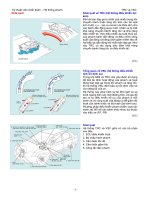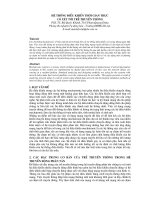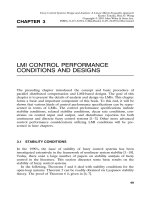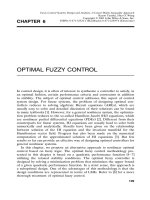Tài liệu Hệ thống điều khiển mờ - Thiết kế và phân tích P4 ppt
Bạn đang xem bản rút gọn của tài liệu. Xem và tải ngay bản đầy đủ của tài liệu tại đây (167.07 KB, 14 trang )
Fuzzy Control Systems Design and Analysis: A Linear Matrix Inequality Approach
Kazuo Tanaka, Hua O. Wang
Copyright ᮊ 2001 John Wiley & Sons, Inc.
Ž. Ž .
ISBNs: 0-471-32324-1 Hardback ; 0-471-22459-6 Electronic
CHAPTER 4
FUZZY OBSERVER DESIGN
In practical applications, the state of a system is often not readily available.
Under such circumstances, the question arises whether it is possible to
determine the state from the system response to some input over some
wx
period of time. For linear systems, a linear observer 1 provides an affirma-
tive answer if the system is observable. Likewise, a systematic design method
of fuzzy regulators and fuzzy observers plays an important role for fuzzy
control systems. This chapter presents the concept of fuzzy observers and two
wx
design procedures for fuzzy observer-based control 2, 3 . In linear system
theory, one of the most important results on observer design is the so-called
separation principle, that is, the controller and observer design can be
carried out separately without compromising the stability of the overall
closed-loop system. In this chapter, it is shown that a similar separation
principle also holds for a large class of fuzzy control systems.
4.1 FUZZY OBSERVER
Up to this point we have mainly dealt with LMI-based fuzzy control designs
involving state feedback. In real-world control problems, however, it is often
the case that the complete information of the states of a system is not always
available. In such cases, one need to resort to output feedback design
methods such as observer-based designs. This chapter presents fuzzy ob-
server design methodologies involving state estimation for T-S fuzzy models.
Alternatively, output feedback design can be treated in the framework of
dynamic feedback, which is the subject of Chapter 12.
83
FUZZY OBSERVATION DESIGN
84
wx
As in all observer designs, fuzzy observers 4 are required to satisfy
x t y x t ™ 0ast ™ ϱ,
Ž. Ž.
ˆ
Ž.
where x t denotes the state vector estimated by a fuzzy observer. This
ˆ
Ž. Ž.
condition guarantees that the steady-state error between x t and x t
ˆ
converges to 0. As in the case of controller design, the PDC concept is
employed to arrive at the following fuzzy observer structures:
CFS
Obser©er Rule i
Ž. Ž.
IF ztis M and иии and ztis M
1 i1 pip
THEN
ˆ
x t s Ax t q Bu t q Kyt y y t ,
Ž. Ž. Ž. Ž. Ž.
Ž.
˙ˆ ˆ
iii
y t s Cx t , i s 1,2,...,r.4.1
Ž. Ž. Ž .
ˆˆ
i
DFS
Obser©er Rule i
Ž. Ž.
IF ztis M and иии and ztis M
1 i1 pip
THEN
x t q 1 s Ax t q Bu t q Kyt y y t ,
Ž . Ž. Ž. Ž. Ž.
Ž.
ˆˆ ˆ
iii
y t s Cx t , i s 1,2,...,r.4.2
Ž. Ž. Ž .
ˆˆ
i
The fuzzy observer has the linear state observer’s laws in its consequent
Ž. Ž.
parts. The steady-state error between x t and x t will be discussed in the
ˆ
next section.
4.2 DESIGN OF AUGMENTED SYSTEMS
This section presents LMI-based designs for an augmented system containing
both the fuzzy controller and observer.
The dependence of the premise variables on the state variables makes it
necessary to consider two cases for fuzzy observer design:
Ž. Ž.
Case A zt,..., ztdo not depend on the state variables estimated by a
1 p
fuzzy observer.
DESIGN OF AUGMENTED SYSTEMS
85
Ž. Ž.
Case B zt,..., ztdepend on the state variables estimated by a fuzzy
1 p
observer.
Obviously the stability analysis and design of the augmented system for
Case A are more straightforward, whereas the stability analysis and design
for Case B are complicated since the premise variables depend on the state
variables, which have to estimated by a fuzzy observer. This fact leads to
Ž.Ž . Ž.Ž .
significant difference between z t Case A and z t Case B in the design
ˆ
of fuzzy observer and controller.
4.2.1 Case A
The fuzzy observer for Case A is represented as follows:
CFS
r
w z t Ax t q Bu t q Kyt y y t
Ä4
Ž. Ž. Ž. Ž. Ž.
Ž. Ž .
ˆˆ
Ý
iiii
i
s1
ˆ
x t s
Ž.
˙
r
w z t
Ž.
Ž.
Ý
i
i
s1
r
s h z t Ax t q Bu t q Kyt y y t ,4.3
Ä4
Ž. Ž. Ž. Ž. Ž. Ž .
Ž. Ž .
ˆˆ
Ý
iiii
i
s1
r
y t s h z t Cx t .4.4
Ž. Ž. Ž. Ž .
Ž.
ˆˆ
Ý
ii
i
s1
DFS
r
w z t Ax t q Bu t q Kyt y y t
Ä4
Ž. Ž. Ž. Ž. Ž.
Ž. Ž .
ˆˆ
Ý
iiii
i
s1
x t q 1 s
Ž.
ˆ
r
w z t
Ž.
Ž.
Ý
i
i
s1
r
s h z t Ax t q Bu t q Kyt y y t ,4.5
Ä4
Ž. Ž. Ž. Ž. Ž. Ž .
Ž. Ž .
ˆˆ
Ý
iiii
i
s1
r
y t s h z t Cx t .4.6
Ž. Ž. Ž. Ž .
Ž.
ˆˆ
Ý
ii
i
s1
ŽŽ..
We use the same weight w z t as that of the ith rule of the fuzzy models
i
Ž. Ž. Ž. Ž.
2.3 and 2.4 , and 2.5 and 2.6 . The fuzzy observer design is to determine
the local gains K in the consequent parts.
i
In the presence of the fuzzy observer for Case A, the PDC fuzzy controller
FUZZY OBSERVATION DESIGN
86
Ž.
takes on the following form, instead of 2.23 :
r
w z t Fx t
Ž. Ž.
Ž.
ˆ
Ý
ii
r
i
s1
u t sy sy h z t Fx t .4.7
Ž. Ž. Ž. Ž .
Ž.
ˆ
Ý
r
ii
i
s1
w z t
Ž.
Ž.
Ý
i
i
s1
Ž. Ž.Ž.
Combining the fuzzy controller 4.7 and the fuzzy observers 4.3 ᎐ 4.6
Ž. Ž. Ž.
and denoting e t s x t y x t , we obtain the following system representa-
ˆ
tions:
CFS
rr
x t s h z thz t A y BF x t q BFe t ,
Ž. Ž. Ž. Ž. Ž.
Ž.Ž.
Ä4
˙
Ž.
ÝÝ
ij iij ij
i
s1 js1
rr
e t s h z thz t A y KC e t .
Ä4
Ž. Ž. Ž. Ž.
Ž.Ž.
˙
ÝÝ
ij iij
i
s1 js1
DFS
rr
x t q 1 s h z thz t A y BF x t q BFe t ,
Ž . Ž. Ž. Ž. Ž.
Ž.Ž.
Ä4
Ž.
ÝÝ
ij iij ij
i
s1 js1
rr
e t q 1 s h z thz t A y KC e t .
Ä4
Ž . Ž. Ž. Ž.
Ž.Ž.
ÝÝ
ij iij
i
s1 js1
Therefore, the augmented systems are represented as follows:
CFS
rr
x t s h z thz t Gx t
Ž. Ž. Ž. Ž.
Ž.Ž.
˙
ÝÝ
aijija
i
s1 js1
r
s h z thz t Gx t
Ž. Ž. Ž.
Ž.Ž.
Ý
ii iia
i
s1
r
G q G
ij ji
q 2 h z thz t x t ,4.8
Ž. Ž. Ž. Ž .
Ž.Ž.
ÝÝ
ij a
2
i
s1 i-j
DFS
rr
x t q 1 s h z thz t Gx t
Ž . Ž. Ž. Ž.
Ž.Ž.
ÝÝ
aijija
i
s1 js1
r
s h z thz t Gx t
Ž. Ž. Ž.
Ž.Ž.
Ý
ii iia
i
s1
r
G q G
ij ji
q 2 h z thz t x t ,4.9
Ž. Ž. Ž. Ž .
Ž.Ž.
ÝÝ
ij a
2
i
s1 i-j
DESIGN OF AUGMENTED SYSTEMS
87
where
x t
Ž.
x t s ,
Ž.
a
e t
Ž.
A y BF BF
iij ij
G s . 4.10
Ž.
ij
0 A y KC
iij
Ž. Ž.
By applying Theorems 7 and 8 to the augmented system 4.8 and 4.9 ,
respectively, we arrive at the following theorems.
wx
THEOREM 16 CFS The equilibrium of the augmented system described by
Ž.
4.8 is globally asymptotically stable if there exists a common positi®e definite
matrix P such that
G
T
P q PG - 0, 4.11
Ž.
ii ii
T
G q GGq G
ij ji ij ji
P q P - 0,
ž/ž/
22
i - j s.t. h l h /
. 4.12
Ž.
ij
Proof. It follows directly from Theorem 7.
wx
THEOREM 17 DFS The equilibrium of the augmented system described by
Ž.
4.9 is globally asymptotically stable if there exists a common positi®e definite
matrix P such that
G
T
PG y P - 0, 4.13
Ž.
ii ii
T
G q GGq G
ij ji ij ji
P y P - 0,
ž/ž/
22
i - j s.t. h l h /
. 4.14
Ž.
ij
Proof. It follows directly from Theorem 8.
Recall that Theorems 9 and 10 represent less conservative conditions than
those of Theorems 7 and 8. Therefore, by applying Theorems 9 and 10 to
Ž. Ž.
4.8 and 4.9 , respectively, we can obtain the following less conservative
conditions:









